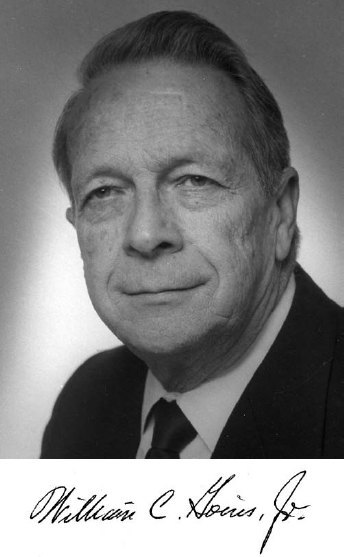1920–2009
Elected in 1990
“For recognition of his pioneering contributions to blowout prevention
leading to safe economical drilling of high-pressure oil-gas wells.”
BY FRANK J. SCHUH
WILLIAM C. “DUB” GOINS, JR., senior vice president of O’Brien-Goins-Simpson & Associates, Inc., and a respected innovator of oil and gas drilling and completion technology, particularly in blowout prevention, died May 22, 2009, at the age of 88.
Dub was born in Dallas, Texas, on December 22, 1920. He was the first son of William Cecil Goins, Sr., and Winnie Lee Richburg. He attended Texas A&M University, where he received a B.S. in chemical engineering in 1942. He served in the Chemical Corps from May 1942 to October 1945, with a final rank of captain.
He joined Gulf Oil Company in 1945 and began a career in drilling and completion engineering and research assignments. He was one of the industry’s top drilling engineering pioneers. While there were many opportunities to improve drilling operations during Dub’s early career, there was little interest in pursuing them at most oil companies.
During the mid-1950s, W. C. “Dub” Goins and his sidekick T. B. O’Brien, however, had the opportunity to work on a high-profile drilling problem, and they used it to become the world’s champions in applying engineering technology to oil drilling operations. They single-handedly changed our nontechnical drilling business into an engineering lead enterprise. The
change occurred so swiftly that “Goins and O’Brien” became the engineering idols of all young engineers who worked in drilling assignments. They earned the right to be labeled the best drilling engineers of all time.
At that time, Gulf Oil Company was the biggest offshore operator in the Gulf of Mexico. Gulf Oil drilled the most wells and had the most production. After the oil downturn that began in 1957, the operations people in the Gulf of Mexico were visited by a vice president of finance out of Gulf Oil’s headquarters. He reportedly explained in significant detail that the company’s offshore oil and gas exploration and production operations were not economical and that “you people” would have the “first chance to bring the costs down.” They were challenged to cut drilling costs in half. Gulf Oil Company started a maximum effort to solve the problem.
At that time, drilling operations were saddled by a maze of customs and concerns that had been followed for years. The engineers normally spent so little time on the rigs that no one had a good idea of what actually went on there. The Gulf engineers moved desks onto their rig floors and manned them 24 hours a day. Goins and O’Brien were heavily involved. They recorded all of the things that were being done and how much time was involved.
The norm in the Gulf Coast at the time was for it to take 30 days to drill to a depth of 10,000 feet. Goins and O’Brien’s record keeping soon led to an action program that was named the “Massive Elimination Program.” They began streamlining operations. They left no sacred cows. They replaced the heavy and viscous mud with the industry’s first seawater mud. They made major improvements in drilling hydraulics and drilling operations. They hit their ultimate performance with a well that reached 10,000 feet in just three days! That was a 90 percent improvement, which I believe to be the best performance ever. They drilled only one well in the record three days, but they changed the 30-day norm for the entire industry to reach 10,000 feet in just 10 days.
In 1982, Goins received the Lester C. Uren Award from the Society of Petroleum Engineers and was named a distinguished engineer of the society. He was elected to the National Academy of Engineering in 1990.
The most extraordinary accomplishments of Goins and O’Brien were to become real-life engineering idols for a whole generation of drilling engineers who became motivated to match or exceed their extraordinary performance.





